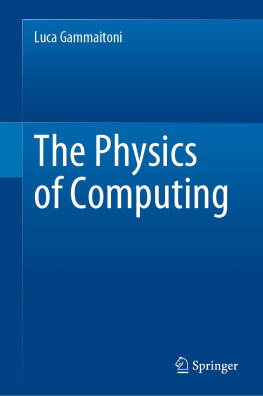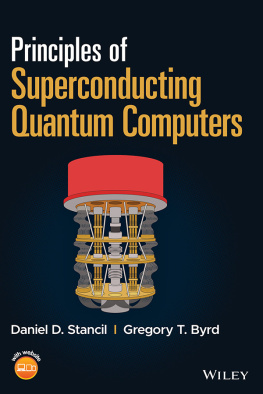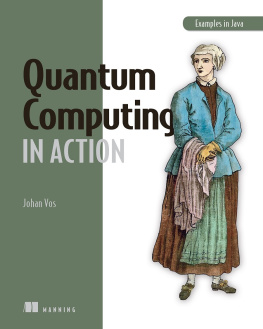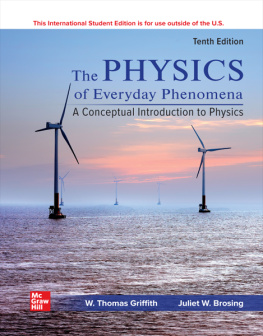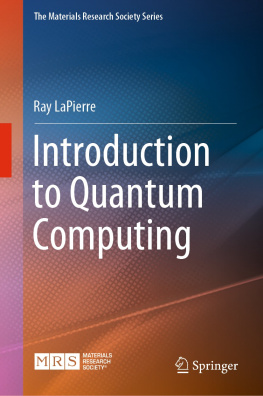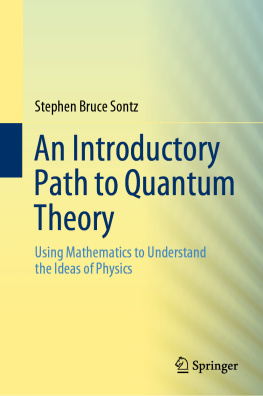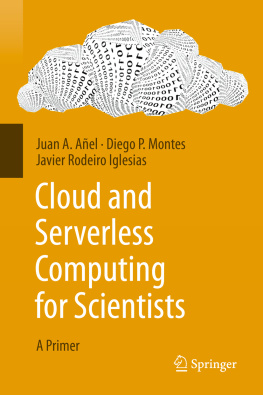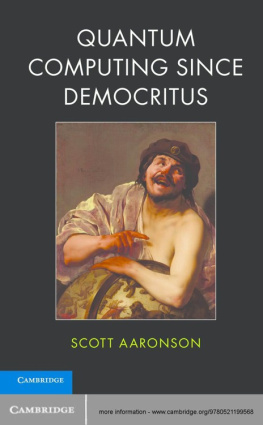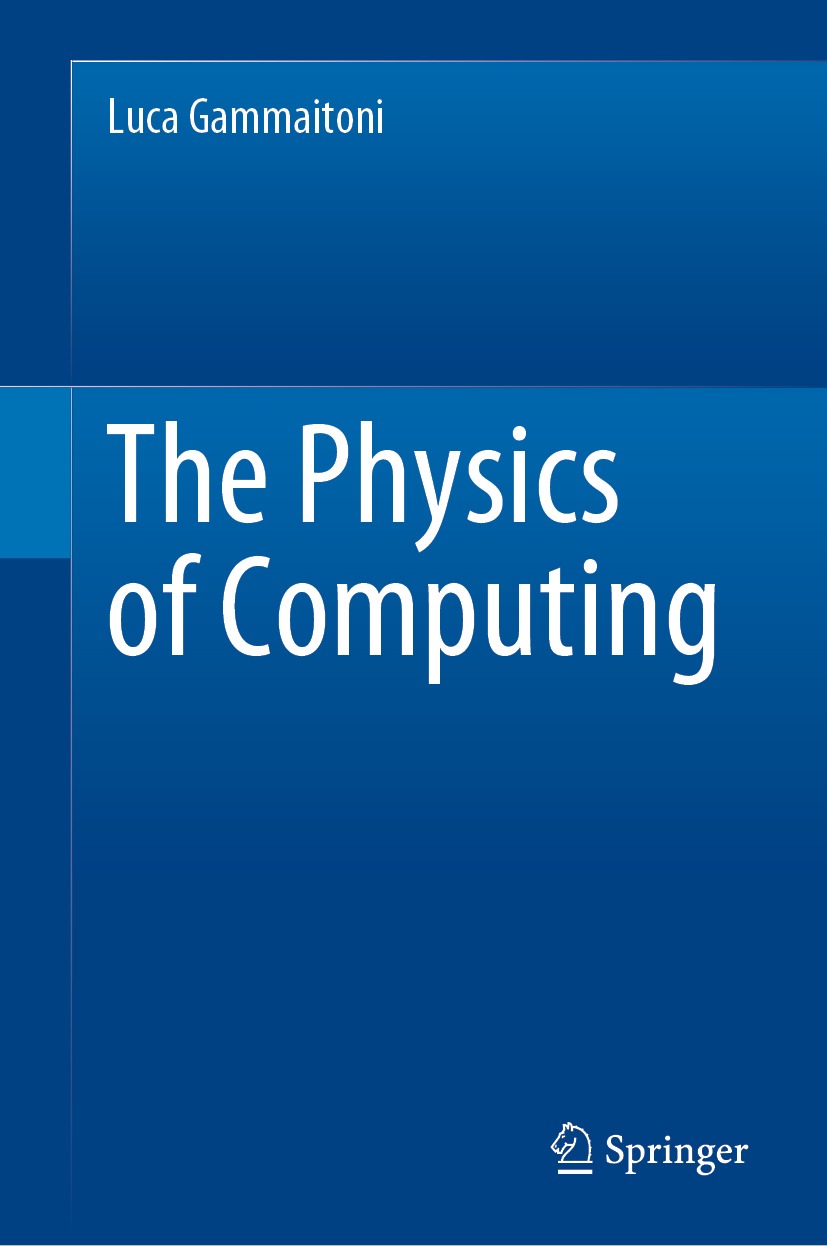Luca Gammaitoni
The Physics of Computing
1st ed. 2021

Logo of the publisher
Luca Gammaitoni
NiPS Laboratory, Universit di Perugia, Perugia, Italy
ISBN 978-3-030-87107-9 e-ISBN 978-3-030-87108-6
https://doi.org/10.1007/978-3-030-87108-6
The Editor(s) (if applicable) and The Author(s), under exclusive license to Springer Nature Switzerland AG 2021
This work is subject to copyright. All rights are solely and exclusively licensed by the Publisher, whether the whole or part of the material is concerned, specifically the rights of translation, reprinting, reuse of illustrations, recitation, broadcasting, reproduction on microfilms or in any other physical way, and transmission or information storage and retrieval, electronic adaptation, computer software, or by similar or dissimilar methodology now known or hereafter developed.
The use of general descriptive names, registered names, trademarks, service marks, etc. in this publication does not imply, even in the absence of a specific statement, that such names are exempt from the relevant protective laws and regulations and therefore free for general use.
The publisher, the authors and the editors are safe to assume that the advice and information in this book are believed to be true and accurate at the date of publication. Neither the publisher nor the authors or the editors give a warranty, expressed or implied, with respect to the material contained herein or for any errors or omissions that may have been made. The publisher remains neutral with regard to jurisdictional claims in published maps and institutional affiliations.
This Springer imprint is published by the registered company Springer Nature Switzerland AG
The registered company address is: Gewerbestrasse 11, 6330 Cham, Switzerland
Preface
This book is about the physics of computing that is not the same as the physics of computers.
Indeed, there are many good books that discuss in detail the functioning of modern computers, with specific reference to the physical principles that rule their operations and this book is not one of them. Here, we are not going to go through any description of semiconductor materials or leakage currents in the last generation of field-effect transistors. You will not be bored with the description of the MOS capacitor or with the lithographic technique required to squeeze more transistors inside the same microprocessor. If you are interested in these arguments, please do not read this book.
How is the physics of computing different from the physics of computers? Well, it is like to say that we are going to talk about the physics of planetary motion; i.e. we are not interested in the dynamics of Jupiter or Mars, but we want to focus our attention to those principles that govern the motion of any of the planets, ignoring the differences among them. In this sense, we are interested in dealing with the fundamental underlying principles (if any) that characterize the computing machines existed, existing and, by definition of fundamental underlying principles, that will ever exist in future.
Such an exaggerated ambition would require a clear and strong definition of what we mean with the words computing and computer. Well, we will try to get away with the following definitions: computing is what a computer does and computer is a device that can be instructed to carry out sequences of arithmetic or logical operations automatically (source: Wikipedia). And we will give for granted that the reader knows what an arithmetic or logical operation is, although we will come back to this point later in the book. Based on these definitions, we can say that computing is merely carrying on a sequence of arithmetic and/or logic operations.
Thus, in this book, we will discuss the fundamental physics principles that rule ANY physical device built to carry on arithmetic and/or logic operations.
Luca Gammaitoni
Perugia, Italy
Acknowledgements
The author owes a debt of gratitude to all friends, colleagues, collaborators and students of Noise in Physical Systems (NiPS) Laboratory at the University of Perugia, for developing the vision which underlies the writing of this book. In particular, he wishes to thank Markus Buttiker, Giovanni Carlotti, Francesco Cottone, Davide Chiuchi, Alessandro Di Michele, Cristina Diamantini, Miquel Lopez-Suarez, Igor Neri, Marco Madami, Fabio Marchesoni, Maurizio Mattarelli, Carlo Presilla, Carlo Trugenberger, Helios Vocca and Angelo Vulpiani. Special thanks to Igor Neri for a careful reading of the ms.
Contents
The Author(s), under exclusive license to Springer Nature Switzerland AG 2021
L. Gammaitoni The Physics of Computing https://doi.org/10.1007/978-3-030-87108-6_1
1. Computing with Devices
Luca Gammaitoni
(1)
NiPS Laboratory, Universit di Perugia, Perugia, Italy
It is unworthy of excellent men to lose hours like slaves in the labor of calculation which could safely be relegated to anyone else if machines were used.
Gottfried Wilhelm Leibnitz (16461716)
Abstract
Computing is a natural act for most of us, nowadays. However, it has not been so for many years, for many people, along the history of humankind. In this chapter, we discuss what do we mean with computing and how this activity can be done with the help of devices. The role of this chapter is to lay the foundations for the development of a treatment of computational processes in terms of the functioning of the physical systems that these processes are called upon to carry out.
1.1 What Do We Mean with Computing?
The term computing comes from the Latin computare, a word composed by the union of cum (with) and putare (to evaluate in quantitative sense). Together they mean to evaluate quantitatively things, strict synonymous of calculating, another Latin originated word that we will consider later on. So, based on this understanding, we could say that computing something has to do with dealing with the quantitative aspects of things.
How do we do that? Since when we were kids, we had to deal with numbers. A number represents a feature of specific properties of ensembles of things. For example: a bunch of cookies in a basket comes with some properties. They are sweet, they may be warm or cold, they may be light or heavy and they may few or many. These properties are evaluated here qualitatively but, if we want to be more precise, we could specify how much these properties are in place. Given our basket of cookies, we can say that they are warm at the touch (more precisely their temperature is 42 C), light if we raise them (more precisely their weight is 320 g), they are many (more precisely they are ten). How do we establish these quantities?
This can be done once we set a unit of measure and a method to compare the same property in different baskets. Comparing is clearly the first attempt to deal with quantities and counting is a very basic comparison. Let us look at how we determine how many cookies are in the basket by performing the counting. We start with the first cookie that comes to hand, and we set our counter to one, and then we increase the counter by one unit for every other cookie in the basket, while marking or displacing the cookies that have already been counted, in order to avoid considering the same cookie more than once. For the counter, we could use our memory or, if we have too many cookies or a lousy memory, we could use some device. The first device that comes handy is our fingers. Things like cookies can have their

